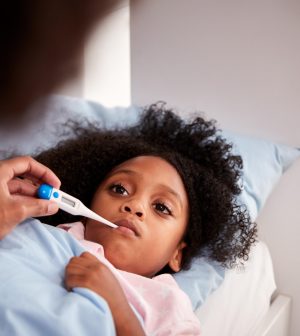- Skip Storing This Everyday Product in the Fridge Door
- Green Tea + B3 Pairing May Boost Brain Health
- Navigating Your Midlife Crisis: Embracing New Possibilities
- City Raccoons Showing Signs of Domestication
- Mapping the Exposome: Science Broadens Focus to Environmental Disease Triggers
- One Week Less on Social Media Linked to Better Mental Health
- Your Brain Changes in Stages as You Age, Study Finds
- Some Suicide Victims Show No Typical Warning Signs, Study Finds
- ByHeart Formula Faces Lawsuits After Babies Sickened With Botulism
- Switch to Vegan Diet Could Cut Your Greenhouse Gas Emissions in Half
How Common Are Co-Infections With COVID, Flu, RSV?

Results from more than 26,000 respiratory tests in late 2022 found simultaneous infections with COVID-19, influenza or respiratory syncytial virus (RSV) in more than 1% of positive tests.
Co-infections were especially widespread in children and teens. In people under age 21, researchers saw a 6% co-infection rate of SARS-CoV-2 and influenza A.
“With changing behaviors as the COVID pandemic began to recede, we felt it was important to investigate the resurgence of other respiratory viruses and potential incidents of co-infection, especially with the additional circulation of SARS-CoV-2,” lead scientist George Pratt said in a news release from the American Association for Clinical Chemistry. He’s technical director at Quest Diagnostics in Marlborough, Mass.
Co-infections tend to occur when there are multiple outbreaks of respiratory diseases. This can happen during flu season in winter.
Patients who have more than one simultaneous infection have a higher risk of severe disease and treatment complications, the researchers noted.
During an epidemic, co-infections can be especially problematic, such as in late 2022 when the U.S. spike in cases of RSV coincided with the ongoing spread of COVID-19 and the arrival of seasonal flu.
For this study, researchers gathered and analyzed more than 26,000 respiratory tests from a clinical laboratory, gathered during a 107-day period. These tests included 9,800 samples from pediatric patients.
The scientists tested the samples for RSV, COVID and influenza A/B.
“The most novel part of our research is the large sample size of results we had available as a part of co-testing in the Northeast,” Pratt said. “Being able to look at over 26,000 test results was a great asset for our study.”
They found that co-infections with two or more of the viruses occurred in 1.33% of positive results and in .55% of the studied samples. Positivity rates varied by the viruses involved, ranging from .38% in adults for both COVID and RSV to 2.28% in adults for both influenza A and COVID.
“As we experience more flu seasons and future epidemics of respiratory viruses, we’ll be able to acquire more co-infection rate data,” Pratt said.
“Our current work would make a useful data point to help evaluate whether future co-infection rates are shrinking or growing,” he added.
Study findings were presented Tuesday at the American Association for Clinical Chemistry annual meeting, in Anaheim, Calif. Findings presented at medical meetings are considered preliminary until published in a peer-reviewed journal.
More information
The U.S. Centers for Disease Control and Prevention has more on RSV.
SOURCE: American Association for Clinical Chemistry, news release, July 25, 2023
Source: HealthDay
Copyright © 2025 HealthDay. All rights reserved.










